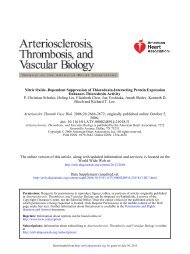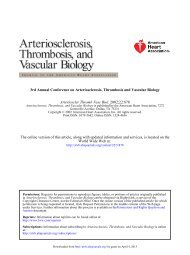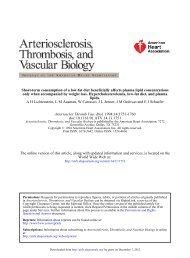CX3CR1 Deficiency Confers Protection From Intimal Hyperplasia ...
CX3CR1 Deficiency Confers Protection From Intimal Hyperplasia ...
CX3CR1 Deficiency Confers Protection From Intimal Hyperplasia ...
You also want an ePaper? Increase the reach of your titles
YUMPU automatically turns print PDFs into web optimized ePapers that Google loves.
monocyte chemotaxis and trafficking to sites of inflammation,<br />
CX 3CR1 mediates direct monocyte binding to its<br />
membrane-bound ligand, CX 3CL1, without the help of other<br />
adhesion molecules, such as integrins. 15 Thus, monocyte<br />
trafficking to damaged tissue during arterial injury may favor<br />
the CX 3CR1–CX 3CL1 system. Recently, Schober et al reported<br />
an alternative mechanism for CCR2 in acute vascular<br />
injury. 25 In their study, CCL2 was found to be co-localized<br />
with platelets on the denuded carotid artery surface of<br />
apoE / mice fed with a high-fat diet within 24 hours after<br />
wire injury. Even though platelets do not contain CCL2, 26<br />
low-affinity CCR2-dependent binding of CCL2 to human<br />
platelets is detected in vitro, 27 suggesting that adherent<br />
platelets with immobilized CCL2 mediate monocyte recruitment<br />
after mechanical injury. Monocyte adhesion to the<br />
luminal surface is not detected within 24 hours under our<br />
experimental conditions or in similar wire-induced arterial<br />
injury models under either normolipidemic 23 or hyperlipidemic<br />
25,28 conditions. Nevertheless, platelet deposition may<br />
play a vital role in the pathogenesis of restenosis, 29 and CCR2<br />
may be involved in that process.<br />
SMC accumulate in the intima in both atherosclerosis and<br />
restenosis. 30,31 This process is also seen in animals following<br />
guidewire-induced arterial injury. CX 3CR1 is expressed in<br />
human SMC cultured from coronary arteries and in atherosclerotic<br />
lesions, 17,18 suggesting that CX 3CR1 may play a role<br />
in regulating SMC function. In our study, intimal hyperplasia<br />
was significantly decreased in CX 3CR1 / arteries after<br />
injury. Concurrently, there were decreased numbers of<br />
VSMC in the neointima. VSMC proliferation in response to<br />
injury was also impaired in CX 3CR1 / mice as measured by<br />
both BrdU incorporation and PCNA immunohistochemistry.<br />
Whether the VSMC effects are primary or secondary cannot<br />
be addressed by this study. However, several data point to a<br />
primary effect of CX 3CR1 on VSMC function in this model.<br />
In a recent report of interleukin (IL)-15’s effect on CX 3CR1/<br />
CX 3CL1 expression and the response to arterial injury, 32<br />
IL-15 attenuated SMC proliferation and CX 3CR1/CX 3CL1<br />
mRNA expression on serum stimulation. Using a periadventitial<br />
injury model, the authors further demonstrated that<br />
IL-15 upregulation after injury reduced intimal thickening,<br />
and blockade of IL-15 increased CX 3CR1/CX 3CL1 expression.<br />
These results suggested that IL-15 up-regulation decreases<br />
neointimal formation in response to arterial injury via<br />
suppressing CX 3CR1 signaling in SMC. CX 3CR1 is a typical<br />
G protein-coupled receptor, and the binding of CX 3CL1 to<br />
CX 3CR1 initiates multiple signal transduction pathways that<br />
are associated with cell proliferation and survival, such as<br />
extracellular signal regulated kinase (ERK)/P38 MAPK pathways<br />
33 and the PI3K/Akt pathway. 34 In addition, tumor<br />
necrosis factor- stimulates CX 3CL1 expression in human<br />
aortic SMC, 35 and the induction of CX 3CR1 facilitates SMC<br />
proliferation via NF-B in aortic SMCs. 20 Additionally,<br />
CX 3CR1/CX 3CL1 may directly regulate SMC migration in<br />
response to vascular inflammation. Cultured human coronary<br />
artery SMC have been shown to express CX 3CR1 and<br />
undergo chemotaxis toward CX 3CL1. 17 US28, a viral receptor<br />
for CX 3CL1 can mediate SMC migration in vitro. 36 Although<br />
direct evidence for a role of CX 3CR1-mediated SMC migra-<br />
Liu et al CX 3CR1 <strong>Deficiency</strong> in Arterial Injury 2061<br />
tion in arterial injury needs to be further demonstrated in<br />
vivo, our findings of substantially reduced intimal hyperplasia<br />
and SMC proliferation in CX 3CR1 / mice after mouse<br />
femoral artery denudation strongly suggest that, in addition to<br />
mediating monocyte infiltration at early stages of the injury<br />
response, CX 3CR1 may also play an important role in<br />
vascular remodeling in the late stage of injury by regulating<br />
SMC functions.<br />
In summary, we demonstrate that CX 3CR1 plays a critical<br />
role in the regulation of cellular responses to acute vascular<br />
injury. CX 3CL1 expression is upregulated on endothelial and<br />
smooth muscle cells after injury. Mice lacking CX 3CR1 have<br />
lower incidence and degree of intimal hyperplasia after<br />
injury. The role of CX 3CR1 in regulating vascular inflammation<br />
involves monocyte accumulation in the vessel wall and<br />
VSMC proliferation and migration. Combined with data that<br />
CX 3CR1 polymorphisms associated with defective cell adhesion<br />
protect humans from atherosclerotic diseases, our findings<br />
suggest that CX 3CR1 could be an effective drug target<br />
for both acute and chronic vascular injuries, such as restenosis<br />
and atherosclerosis.<br />
Acknowledgments<br />
The authors sincerely thank Gail Grossman and Kirk McNaughton<br />
for their technical assistance in tissue processing and staining, Rishi<br />
Rampersad for animal husbandry and Drs Teresa Tarrant and Maya<br />
Jerath for proofreading the manuscript.<br />
Sources of Funding<br />
This study was supported by National Institute of Health R01s<br />
CA098110 (D.D.P.) and HL074219 (S.S.S.).<br />
None.<br />
Disclosures<br />
References<br />
1. Ross R. Atherosclerosis–an inflammatory disease. N Engl J Med. 1999;<br />
340:115–126.<br />
2. Schwartz SM, deBlois D, O’Brien ER. The intima. Soil for atherosclerosis<br />
and restenosis. Circ Res. 1995;77:445–465.<br />
3. Charo IF, Taubman MB. Chemokines in the pathogenesis of vascular<br />
disease. Circ Res. 2004;95:858–866.<br />
4. Combadiere C, Potteaux S, Gao JL, Esposito B, Casanova S, Lee EJ,<br />
Debre P, Tedgui A, Murphy PM, Mallat Z. Decreased atherosclerotic<br />
lesion formation in <strong>CX3CR1</strong>/apolipoprotein E double knockout mice.<br />
Circulation. 2003;107:1009–1016.<br />
5. Lesnik P, Haskell CA, Charo IF. Decreased atherosclerosis in <strong>CX3CR1</strong>-/mice<br />
reveals a role for fractalkine in atherogenesis. J Clin Invest. 2003;<br />
111:333–340.<br />
6. Teupser D, Pavlides S, Tan M, Gutierrez-Ramos JC, Kolbeck R, Breslow<br />
JL. Major reduction of atherosclerosis in fractalkine (CX3CL1)-deficient<br />
mice is at the brachiocephalic artery, not the aortic root. Proc Natl Acad<br />
Sci U S A. 2004;101:17795–17800.<br />
7. McDermott DH, Fong AM, Yang Q, Sechler JM, Cupples LA, Merrell<br />
MN, Wilson PW, D’Agostino RB, O’Donnell CJ, Patel DD, Murphy PM.<br />
Chemokine receptor mutant <strong>CX3CR1</strong>–M280 has impaired adhesive<br />
function and correlates with protection from cardiovascular disease in<br />
humans. J Clin Invest. 2003;111:1241–1250.<br />
8. McDermott DH, Halcox JP, Schenke WH, Waclawiw MA, Merrell MN,<br />
Epstein N, Quyyumi AA, Murphy PM. Association between polymorphism<br />
in the chemokine receptor <strong>CX3CR1</strong> and coronary vascular<br />
endothelial dysfunction and atherosclerosis. Circ Res. 2001;89:401–407.<br />
9. Moatti D, Faure S, Fumeron F, Amara Mel W, Seknadji P, McDermott<br />
DH, Debre P, Aumont MC, Murphy PM, de Prost D, Combadiere C.<br />
Polymorphism in the fractalkine receptor <strong>CX3CR1</strong> as a genetic risk factor<br />
for coronary artery disease. Blood. 2001;97:1925–1928.<br />
Downloaded from<br />
http://atvb.ahajournals.org/ by guest on March 25, 2013














